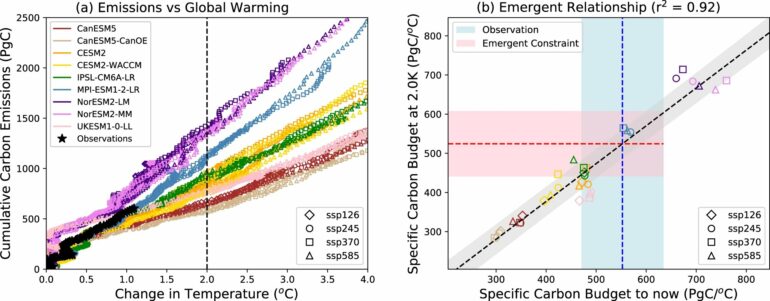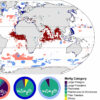A team of scientists from the University of Exeter, Met Office, and Imperial College have found a new way to calculate the total carbon emissions consistent with the Paris climate targets of 1.5°C and 2°C of global warming.
Although the exceptionally warm climate in 2023 was close to exceeding the 1.5°C level, the Paris targets relate to the average warming over ten or more years.
The new study answers the question: how much carbon have we got left before we pass the Paris limits?
About 15 years ago, climate scientists discovered a remarkably useful fact about climate change. Despite the vast complexity of the climate system, global warming depends overwhelmingly on the total carbon dioxide emissions since pre-industrial times.
This discovery opened up the possibility of defining total carbon budgets consistent with the Paris targets and led to the definition of Net Zero as the point at which global warming essentially stops. The problem is that the Earth System Models used to make climate projections disagree hugely about how much global warming we will get for a billion tons of carbon emissions.
The new study solves this problem by showing that observed global warming and estimated carbon emissions up to the current day are a really good indicator of how much carbon emissions are left before we pass the Paris climate targets. The authors do this by what they call an “Emergent Constraint,” which is a fancy name for something quite simple.
Basically, they look at results from all of the available Earth System Models, which form a lovely straight line linking emissions per °C of global warming up to now with emissions for a given level of future global warming. This means that the best estimates of global warming and emissions up to the current day can be converted simply into estimates of the total carbon budget for the Paris climate targets.
The good news is that the new study estimates emissions budgets that are at least 10% larger than the average value for the models. The bad news is that if humankind continues to emit carbon at the current rate, we have a little more than a decade before we exceed the Paris 1.5°C target, even for decade-mean warming.
Co-author Chris Jones from the Met Office said, “This emergent constraint is elegant and powerful. It both uses observations to narrow the possible range of future emissions but also lets us consider other greenhouse gases than just CO2. In this way, the remaining carbon budget is made much more policy relevant.”
Lead author Peter Cox, Director of the Global Systems Institute at the University of Exeter, said, “Our study clarifies the climate problem that needs to be solved, and we hope that it will stimulate greater efforts to reduce our emissions to Net Zero.”
The work is published in the journal Nature Communications.
More information:
Peter M. Cox et al, Emergent constraints on carbon budgets as a function of global warming, Nature Communications (2024). DOI: 10.1038/s41467-024-46137-7
Provided by
University of Exeter
Citation:
A better handle on the emissions budget for the Paris climate targets (2024, March 8)



